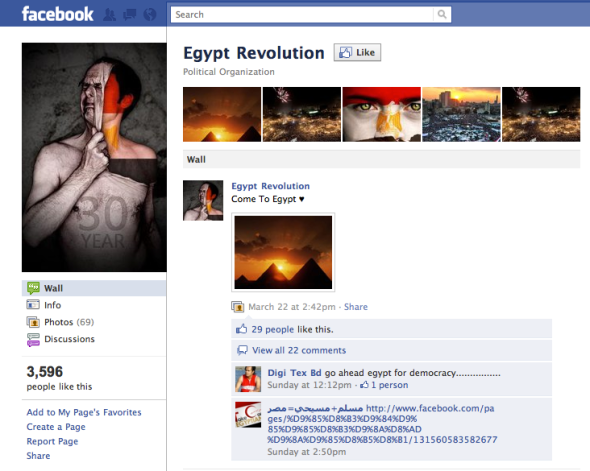Inside Cairo
Al Jazeera, the 24 hour news channel based on the outskirts of Doha, shows more graphic imagery than the BBC, ITN or Sky. It was the channel of choice for Bin Laden’s message after 9/11, and is now the channel of choice for breaking news now that the spotlight is on the Middle East revolutions – breaking news from clips such as the YouTube offering that seemed to confirm that Gaddafi security forces were attacking civilians. The scenes on Al Jazeera are more grizzly. They are not afraid of controversy. You will often see corpses and blood. On New York’s Daily Beast, the health warning of “graphic imagery” will accompany most clips aggregated from Al Jazeera. According to a recent article in The Sunday Times, there’s greater use of new media such as their Twitter feed and mobile phone footage downloaded from Facebook.
These videos add to the sense of immediacy and constant news. There’s always this question – how verifiable is this footage – is there an agenda behind posting graphic imagery. Can this immediacy be manipulated either by the rebels, or the regime?
By strange inversion, in the autocratic states themselves, TV is the untrusted medium. In Egypt, more trust is invested by the public in footage uploaded onto social networks which in turn makes the news on Al Jazeera, a channel which has been banned in Libya, and was also banned in Egypt after the uprisings.
“The way the news is presented is more sensationalist,” says Alex Hands, artistic director of Land in Focus, living in Cairo at the time of the revolutions. “The regime announced curfews during the revolution, but they were completely ignored. There was only rumour of when the curfew was. It was on TV but people didn’t believe State TV at the time and there wasn’t the internet to confirm these things.”
It may be a strange inversion, but when the broadcast medium is monopolised by the untrusted state, perhaps it is no wonder that the trust lies with footage edited by the people.
Words – HL
The Insider: Haroon Siddique, Guardian.co.uk news reporter

Haroon Siddique, a Guardian.co.uk news reporter, chatted to iVideocracy about the impact of video on online journalism, citizen journalism and the uprising in Egypt.
iV: How has video journalism affected online journalism?
HS: One of the most striking cases of how video journalism has affected online journalism – and in fact all journalism – was Guardian.co.uk’s coverage of the G20 protests and the revelation that Ian Tomlinson died after being struck and pushed to the ground by a police officer. While witness reports are valuable, they can be contradicted or doubts can be cast upon them. But video evidence of the actual incident in question is incontrovertible. It is often said that a picture paints a thousand words and the impact of video is similar, if not stronger.
iV: Has this increased the use of citizen journalism?
HS: Yes. Traditional newspapers use their own video to enhance their coverage and give their audience something they would previously have had to go to a TV channel to get, but more interesting is the way videos taken by ordinary citizens, often on mobile phones, have provided first-hand coverage of events that traditional news organisations would probably never have obtained footage of. A friend said to me, “Imagine the public response during the miners’ strike if people had had mobile footage of the police brutality used against the strikers.” The BBC carried footage of violence during the strike, but some news organisations’ narratives (that police officers had responded to violence by the miners or that police tactics were proportionate and restrained) was enough to cloud responsibility of who was to blame in the eyes of many people. If there had been a Tomlinson moment captured on camera, the public response might have been very different.
iV: You’ve been covering the events in Egypt. Has video / citizen journalism been important in that coverage?
HS: Yes, video – often provided by citizens – has been an invaluable tool in covering the events in Egypt. There has been footage of people being shot dead, tear-gassed, beaten. No matter how much despotic regimes try to stop media coverage, the easy availability of mobile phones, which can film video, makes it much harder for them to hide their abuses.
Words – JB


